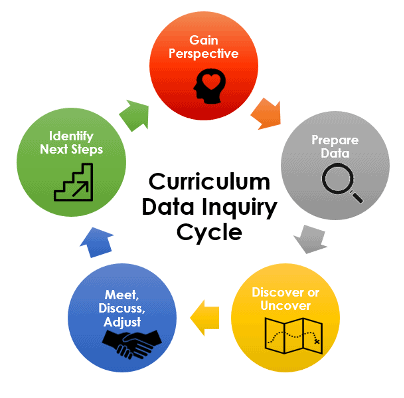- To support data-driven curriculum planning, we’ve developed a step-by-step approach to guide your curriculum cycle.
- As you read, consider the following Essential Questions:
 Download our worksheet to walk your team through the curriculum review cycle.
Next, we are going to review our five-step curriculum cycle to review and adjust curriculum to maximize student learning.
Download our worksheet to walk your team through the curriculum review cycle.
Next, we are going to review our five-step curriculum cycle to review and adjust curriculum to maximize student learning.
Step 1: Gain Perspective with Driving Questions
The first step is to figure out what you want to focus on. When you think about your students, what have you noticed? When do you see them struggle? The goal of gaining perspective is to identify the most important questions you want to answer with the data. These are your driving questions. As a practitioner, this allows you to really use curriculum data to zero in on what matters most. To do this, take a few minutes to identify the most important questions you have about your students. Think through:- What are the key questions you trying to answer?
- What curriculum changes could you make if you were able to answer this question?
- Based on all of this, how high of a priority is this question?
Step 2: Prepare Data for Review
Ok, now that we’ve thought through what we want to answer. Let’s gather and prepare our data. Again we will want to think through some questions such as: What information or resources will help answer your question? In other words, what kind of data should you gather? We would suggest including:- Assessment Results
- Curriculum Maps
- Instructional Resources & Activities
- Student Work
- Behavioral Data
- Your confidence in the information
- The reliability of the data
- The significance of what they reflect
Step 3: Analyze Data and Gather Findings
Now that we have our driving questions and data at hand, we can begin to use our data. This can be done in teams or as an individual teacher. Based on your formative and summative assessment results, identify the standards you need to focus on to increase student growth. Here is where we turn from our assessment data to our curriculum maps to uncover and discover where in the curriculum these standards are taught. As you make the connections from curriculum to assessment, ask yourself, what confirms your expectations? Why did you have these expectations? What surprises you? Next, review your class resources and activities to see where and how these standards are addressed. As you do this, think through want you want students to learn by asking yourself:- Where does engagement live in these standards?
- What strategies could we create to address these standards?
Step 4: Meet, Discuss, Adjust
Based on your findings from assessment results, curriculum, and various classroom resources, what changes are you going to make to your curriculum? How will you adjust your classroom instruction and modify learning activities? We can turn to colleagues for ideas and support. In a grade level or subject-specific PLC meeting, we might brainstorm and share different ways we target these standards. To support collaboration, consider creating a spreadsheet where individuals can list standards and teachers can offer grade-specific resources or activities aligned to that standard.Step 5: Identify Next Steps
Once you’ve made adjustments to your curriculum and instruction, reflect on how they impacted student learning. Consider setting SMART goals for your driving questions as a way to gauge your progress. Finally, think about what area of your curriculum you need to focus on next. Let’s return briefly to the Essential Question posed at the beginning of this post:- How can you use student assessment data to drive curriculum development as part of a curriculum review process?
- What other conversations or areas of focus can drive curriculum development as part of a curriculum review process?

